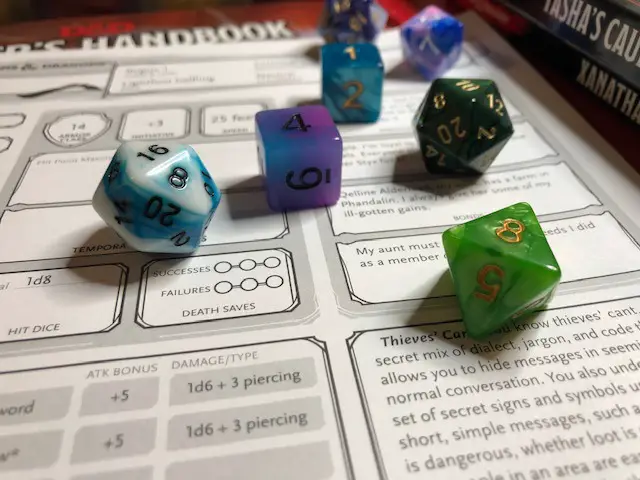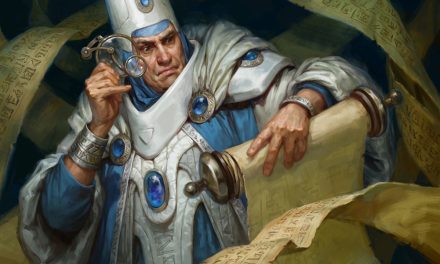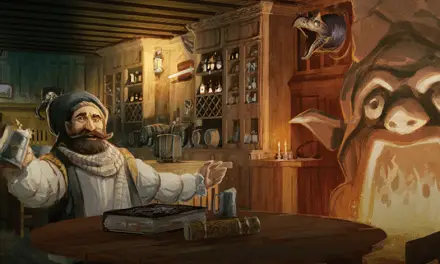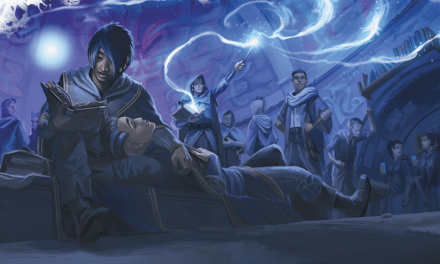So, you’ve just started D&D 5e and are looking at your character sheet. It has all sorts of information on it that you don’t understand and the more you try to figure out what each thing does the more confused you get!
You might even swear that the blank sheet before you is mocking you as you try to make sense of it.
If so, don’t worry! I’ve got your back!
In this guide, we will discuss how to read a D&D character sheet by breaking down the different parts of it and explaining what they do in simple terms.
What Is a Character Sheet?
A character sheet is a document that contains information about your D&D character.
This includes their name, race, character class, and level. It also shows all of the character’s ability scores (like dexterity or intelligence), skills they have learned along the way (such as stealth or acrobatics), how many spells slots they have, and so on.
This is the most important thing for players to understand when playing D&D. Not only will knowing how to read your character sheet help the game move along, but it will also help you and your DM understand what your character is capable of doing.
But even though being familiar with reading character sheets is absolutely essential to being an awesome D&D player, don’t worry!
Familiarity will come with time, but this guide is here to help you speed that process up!
Breaking Down the Elements of the 5e Character Sheet
D&D character sheets have a ton of information on them which can be confusing for new players.
The 5th edition Player’s Handbook has tons of great information, but it is hard to find what you’re looking for in the book when you’re trying to decipher what everything on your sheet means and your eyes are focused on what’s happening in the game.
I totally get it and have helped countless new players learn the ropes!
So this guide will break down each section of the character sheet so that you can understand everything about your character without having to take notes or spend more time doing “homework” than playing the game!
There are tons of custom-made character sheets out there, but we’re going to focus on the standard character sheet for these examples.
If you’re using a different one, it should contain this same information but might be in a different location on the page.
Need character sheets? Wizards of the Coast has made them available to download for free here.
I recommend printing out a blank character sheet to fill in as you follow along with this guide.
Character Information
The top section of your character sheet is where you establish your character’s identity.
No longer are they just a wireframe – they are now a living, breathing person in your game’s world!
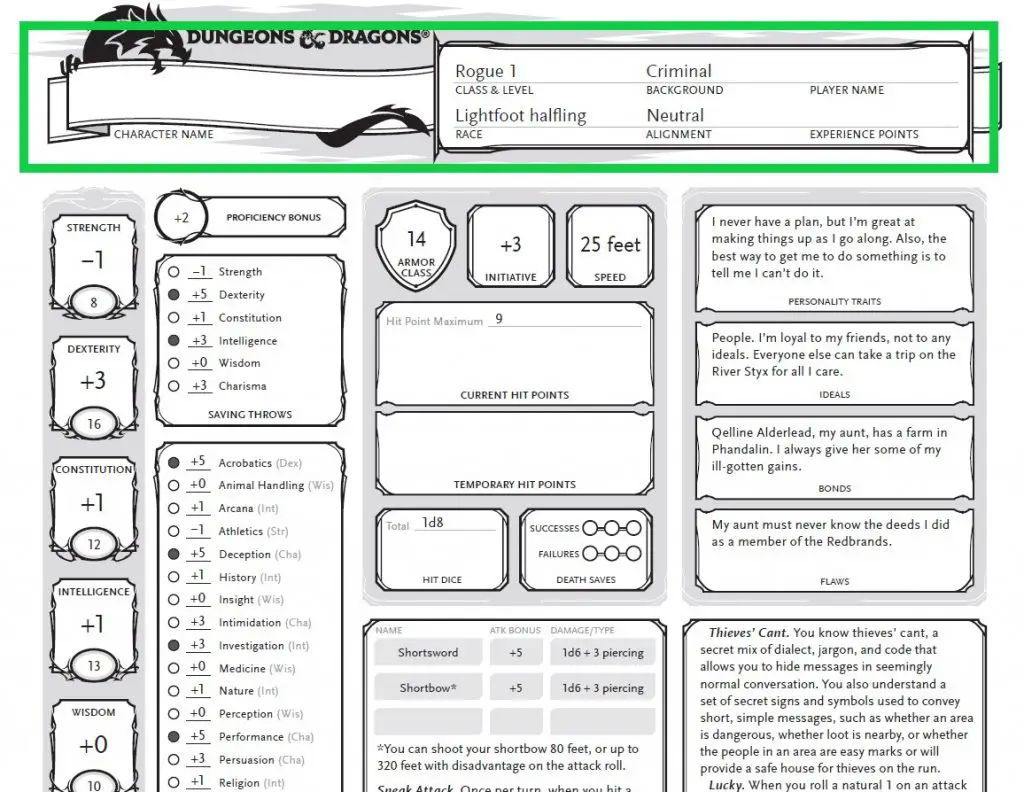
The elements of this section are:
Character Name: This is your character’s name. Have fun with it!
Player Name: Your name. (Helps prevent mixups at the table!)
Character Class: Your character’s class. (Fighter, Wizard, Rogue, etc.)
Level: Your character’s level. This is determined by the amount of experience points they have gained up to this point. Check with your DM to find out what level you are starting at.
Character Background: This relates to your character backstory and gives you special bonuses based on which background you choose.
Character’s Race: Are you a human? Elf? Dwarf? Something else?
Alignment: This relates to your character’s personality, morality and worldview. Are they a Lawful Good hero or a Neutral Evil character who will do whatever foul things they can get away with?
Experience Points: Much like with your character’s level, check with your DM to see how much experience (also known as EXP or XP) you will be starting with. As you gain experience, you’ll level up and gain all kinds of new abilities!
Ability Scores
Your character’s ability scores represent how well your character performs in six distinct areas: Strength, Dexterity, Constitution, Intelligence, Wisdom, and Charisma.
I covered what these abilities all mean in a different article that you can read here.
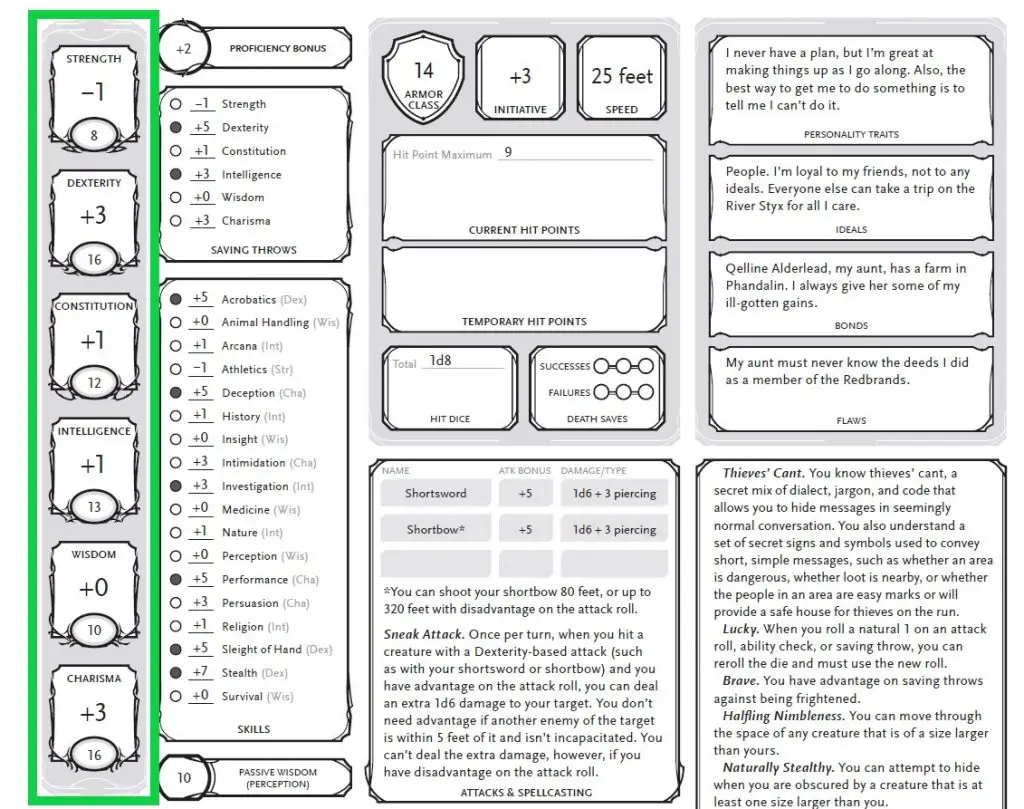
You’ll be using these A LOT throughout your game.
Depending on your Dungeon Master and how the group works, there are several ways that these scores might be generated. Check with your Dungeon Master to see how ability scores are generated in your group.
Related: 5 Ways to Determine Character Ability Scores in 5e
Each ability score has a corresponding ability score modifier. These modifiers are used for several different things that your character might do throughout the adventure.
You can find the ability score in the smaller bubble under the ability score modifiers. Whether you add or subtract that modifier number from relevant rolls is shown by whether you see a plus or minus sign in front of this modifier.
This table will show you the ability modifier for each score.
| Ability Score | Modifier |
| 2 – 3 | -4 |
| 4 – 5 | -3 |
| 6 – 7 | -2 |
| 8 – 9 | -1 |
| 10 – 11 | +0 |
| 12 – 13 | +1 |
| 14 – 15 | +2 |
| 16 – 17 | +3 |
| 18 – 19 | +4 |
| 20 + | +5 |
A character who will be lifting heavy things or wielding a mighty warhammer will benefit from a higher strength modifier and score.
However, a wizard might ignore their Strength ability score in favor of investing in a higher intelligence score (which is their spellcasting ability that they use to cast spells) instead.
Certain ability scores are more important to some classes than others. Always be sure to check out your chosen class in The Player’s Handbook to see which ability scores are most important to your class.
(Or you can always check back here as I am working to get more class guides published! If you sign up for the email newsletter, you’ll be the first to know!)
Unless you’re using the new character creation rules from Tasha’s Cauldron of Everything, your character’s race will give you extra bonuses for specific abilities. Make sure you include those bonuses as well!
You Might Like: How To Make Your First D&D Character!
Saving Throws
Closely related to your ability scores are their corresponding saving throws.
Where you roll with an ability score to do something with a relevant ability modifier (like a Strength check to kick in a door), it works a little differently if you’re trying to avoid or resist something.
Saving throws are mostly the same as your ability modifiers, but two of these will get a bonus based on what class you have chosen.
A Rogue, for example, might try to quickly jump out of the way of a falling rock trap. Because Rogues get bonuses to Dexterity and Intelligence saving throws, this character adds their proficiency bonus plus their dexterity modifier to the roll.
If the party’s wizard sets off the trap, they will have a harder time getting out of the way. The Wizard adds their proficiency bonus to Intelligence and Wisdom saving throws, but not dexterity saves. Because of this, the Wizard only gets the benefit of their dexterity modifier.
In the Saving Throws section of your character sheet, you’ll see the six ability scores. Bubble in the ones that your class is proficient in (found in the player’s handbook) and fill in the scores as appropriate.
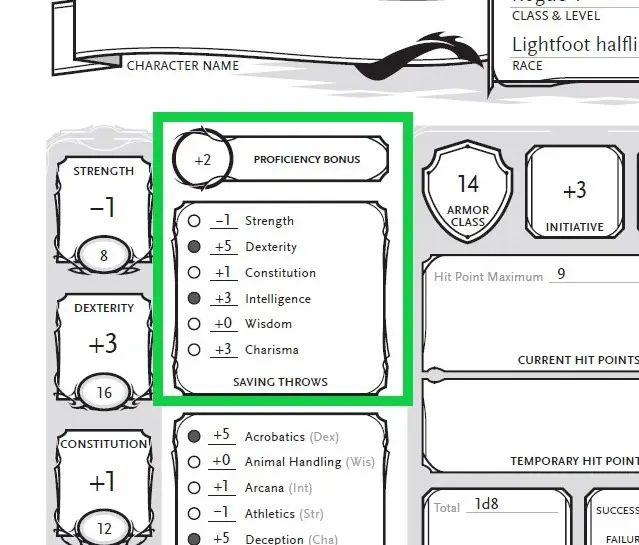
Proficiency Bonus
Your character’s proficiency bonus is determined by their level.
You’ll see the area to fill in your character’s proficiency bonus next to their ability scores.
This proficiency modifier increases by one at levels 5, 9, 13, and 17.
You add this bonus to any rolls for something that you have proficiency in. That means saving throws, skill checks, weapon attacks, and using tools that you are trained with.
Inspiration
Unless you are using a homebrew method of Inspiration in your Dungeons and Dragons game, this is a binary section on your character sheet – you either have Inspiration or you don’t.
Inspiration is a fun mechanic that is meant to encourage roleplaying and clever gameplay in your Dungeons and Dragons game.
Dungeon Masters or other players can grant your character inspiration for doing things that add to the excitement of the game. This might be for roleplaying your character’s personality traits well, doing something exceptionally heroic, or anything else that the DM wants to reward you for.
Read: How Does Inspiration Work in D&D 5e?
When you have inspiration, just indicate (with a checkmark or some other such symbol) that you have it.
Using Inspiration gives you advantage on an attack roll, saving throw, or ability check.
Once you have used your Inspiration, you can simply erase the checkmark in this field.
Skills
Skills in Dungeons and Dragons are how you make your character stand out from the other characters.
D&D has 18 skills, which are each used to do different things in the game. You’ll likely be very good at some of these and not particularly useful with others.
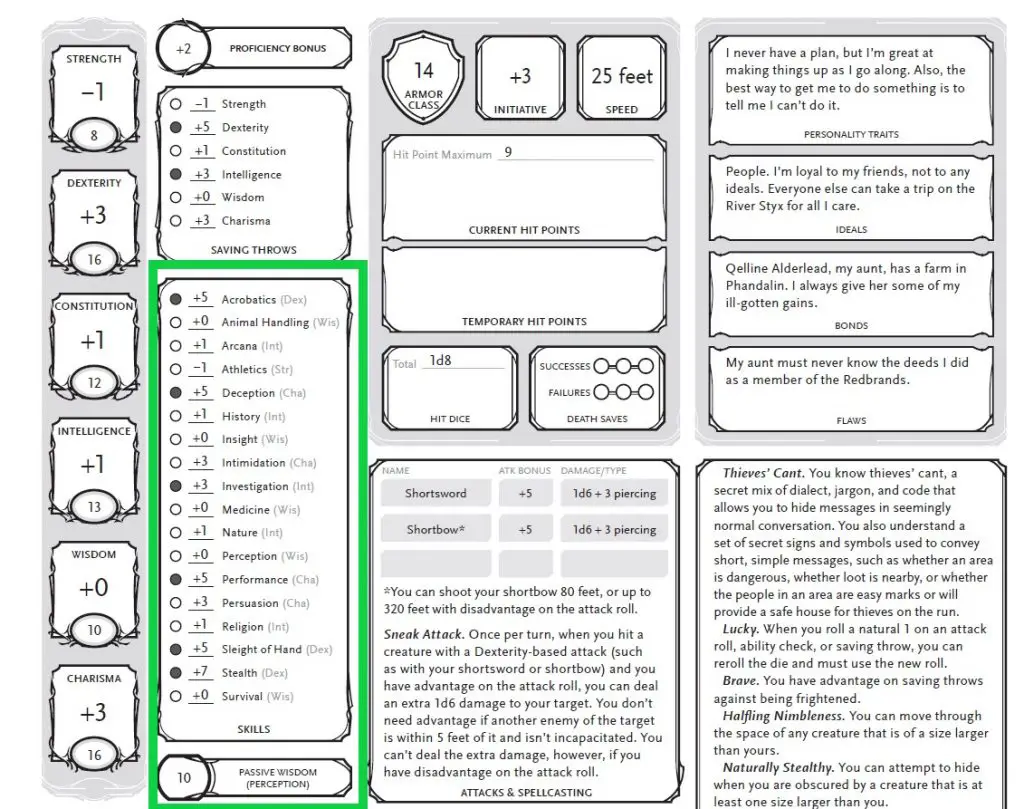
You can see the relevant ability modifier for each skill abbreviated next to it. (Dex = Dexterity modifier, Str = Strength Modifier, etc)
The plus or minus next to each of these skills represent how much you add or subtract from a roll to attempt such a skill. This number represents the relevant ability modifier plus your proficiency bonus if you are proficient in that skill.
Related: How and When To Use Social Skills
For example, the Arcana skill represents how much your character knows about magical effects, magic items, and so on. This skill is based on your character’s Intelligence modifier.
The Rogue in our example is not proficient in this skill but does have a +1 Intelligence modifier. While they won’t be adding their +2 proficiency bonus to this roll, they do get the +1 from their Intelligence Modifier.
This character is proficient in the Investigation skill though. When trying to find hidden clues (like when checking for traps), the Rogue gets a +3 to their roll.
However, if this character finds themselves in a situation requiring an Athletics skill check (like swimming against a strong current), they might have a difficult time. With no proficiency and a negative Strength modifier, the character takes a -1 to any Athletics rolls that they have to make.
Your DM will tell you which skill is most appropriate for whatever action you want to take.
Below the Skills area, you’ll also see a spot to list your Passive Perception. This is equal to 10 + your Perception skill bonus. Passive Perception is your ability to notice things without actively looking for them. (Handy for avoiding pickpockets or spotting eavesdroppers!)
Combat
In the top-middle section of the character sheet, you have several elements that focus on your character’s combat performance.
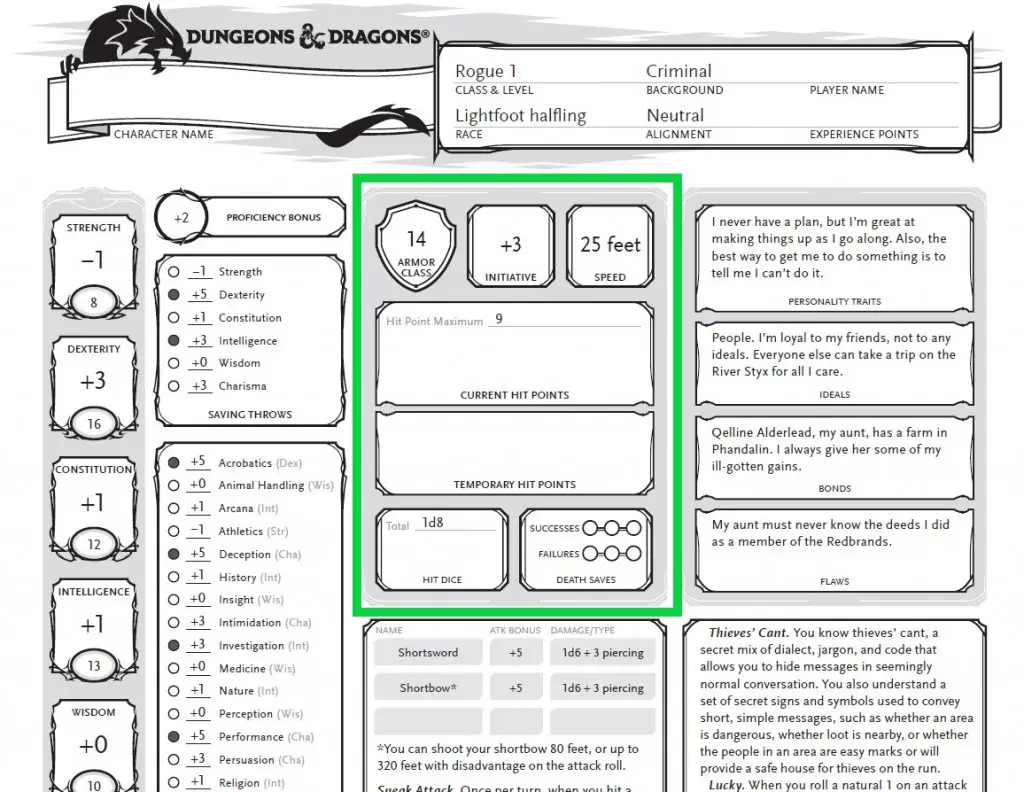
Starting at the top, you see your character’s AC (Armor Class), Initiative, and Speed.
Armor Class represents how difficult your character is to hit. This increases by your character getting faster (raising their Dexterity modifier), wearing armor, or both. An enemy attack must be greater than or equal to your character’s AC to deal damage.
Initiative is used when determining the turn order in combat. A higher initiative increases your likelihood of going earlier in combat. This is based on your Dexterity modifier as well. You’ll add this number (subtracting if it’s a negative) to your result when combat starts and the DM has everyone “roll for initiative.”
Your speed is how quickly you can move. Movement in D&D 5e is based on 5-foot squares. Most characters have a standard speed of 30 feet, though some have more or less. The Halfling Rogue in this example has a movement speed of 25 feet as Halflings move below the standard speed.
Hit Points represent your character’s vitality. How much damage they can take in combat is determined by this.
The number of hit points available to you is determined by your class, level, and constitution modifier. This number is your hit point maximum and gets written in the top section of the “Current Hit Points” box.
When you take damage, you’ll write your new hit point total in the lower portion of the “Current Hit Points” box. When you get healed, your current number of hit points can’t exceed your hit point maximum.
However…
Some spells and effects will give you temporary hit points. These are tracked separately from your regular hit points in the Temporary Hit Points area of your character sheet.
(Just a quick note that you can recover regular hit points but can’t regain temporary hit points!)
Dropping to zero hit points means that your character falls unconscious and will need to begin making death saving throws.
Related: Dropping to Zero Hit Points and Death Saves Explained
The Death Saves area of your character sheet is for tracking the number of successes and failures on your death saving throws. Three successes and you regain consciousness. Three death saving throw failures and your character has died.
Hit dice are used during a short rest to recover hit points. The amount of hit dice available to you is based on your level. Which dice you use to recover these hit points is determined by your class.
When using a hit die to regain HP, you roll the die appropriate for your class and add your constitution modifier. Regain that many hit points.
Attacks & Spellcasting
The Attacks & Spellcasting section of your character sheet is where you put information related to the ranged and melee weapons your character uses in combat.
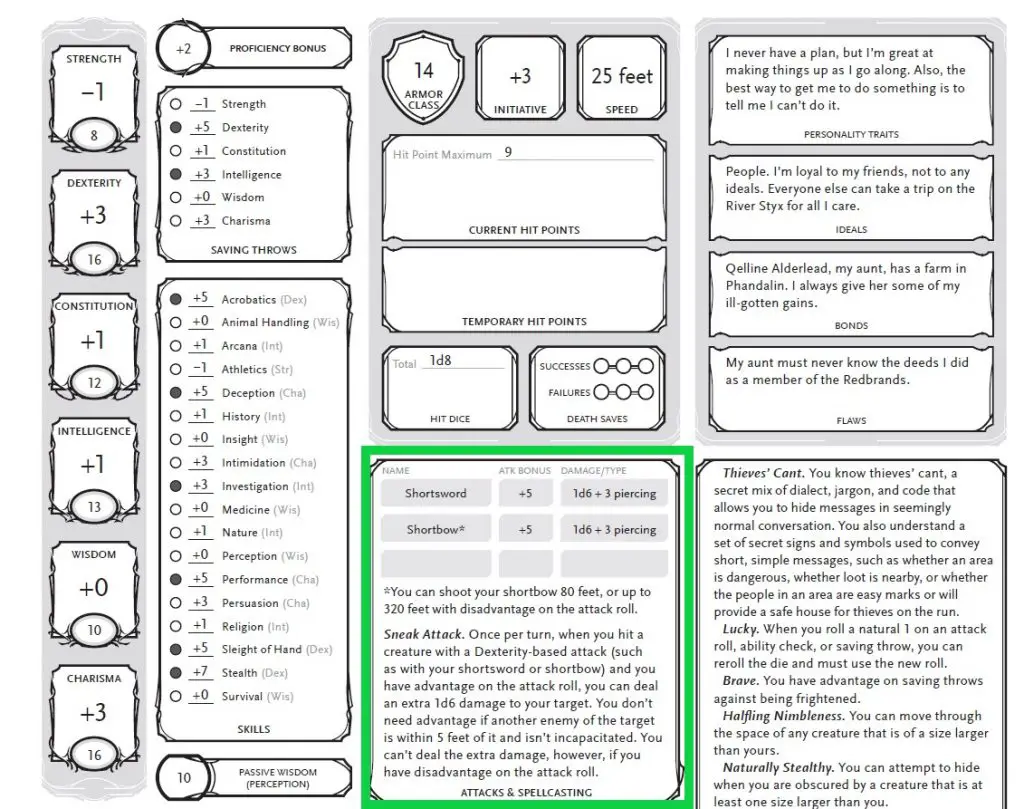
Put the weapon’s name (shortsword, quarterstaff, shortbow, etc.) in the left column.
The middle column is the weapon’s attack bonus (proficiency bonus + Strength or Dexterity modifier [depending on the weapon]).
In the last column, write the damage that the weapon deals on a successful attack roll.
So the Rogue in our example has a +5 attack modifier when attacking with a shortsword or shortbow. (This is the +3 from their dexterity modifier and +2 from their proficiency bonus.) On a hit, the character deals 1d6+3 damage.
To learn what 1d6 means check out this article to learn your dice!
Spellcasters can also put commonly-used spells in this area as well.
Because some spells are “Ranged Spell Attacks” that use the caster’s proficiency modifier and spellcasting ability to determine the spell attack modifier, it can be very handy to have this information readily available for a few favorite spells like Fire Bolt or Chromatic Orb.
There’s a fair bit of room in this box for quick notes that are related to your attacks or spellcasting features.
This example has the Rogue’s Sneak Attack feature description handy. Because Rogues rely heavily on this feature to deal large amounts of damage, it’s important to have the ability visible on your character sheet so you’re less likely to forget to use it!
You’ll also see that there’s a quick note about how ranged weapons work. This is vital information if the Rogue wants to find a good position and fight from a distance.
If you’re playing a spellcaster, this could be a good place to jot down your spell save DC for when enemies have to make saving throws against your spells.
The spell save DC is calculated as 8 + your proficiency bonus + your ability modifier. You’ll want to have this number handy if you tend to cast spells that require your targets to make saving throws.
Personality Traits
Part of the character creation process is figuring out what makes your character tick.
What is their personality like? Who and what do they care about?
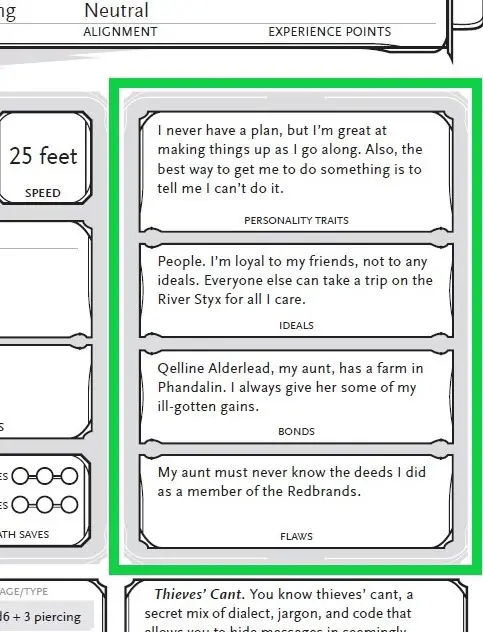
You can find inspiration for the answers to these questions in the Backgrounds section of the Player’s Handbook.
Write your character’s traits, flaws, ideals, and bonds in the section at the top right of the character sheet. These serve as guides for your roleplaying.
Also Check Out: The ONE Question To Make Better Characters!
Features & Traits
At the bottom right of the character sheet is the largest box on the page. This is for writing down your character’s class features and traits.
Traits are abilities that you gain from your character’s race.
For example, Lightfoot Halflings gain the Lucky, Brave, Halfling Nimbleness, and Naturally Stealthy traits. Those (and their respective effects) are written here for quick reference.
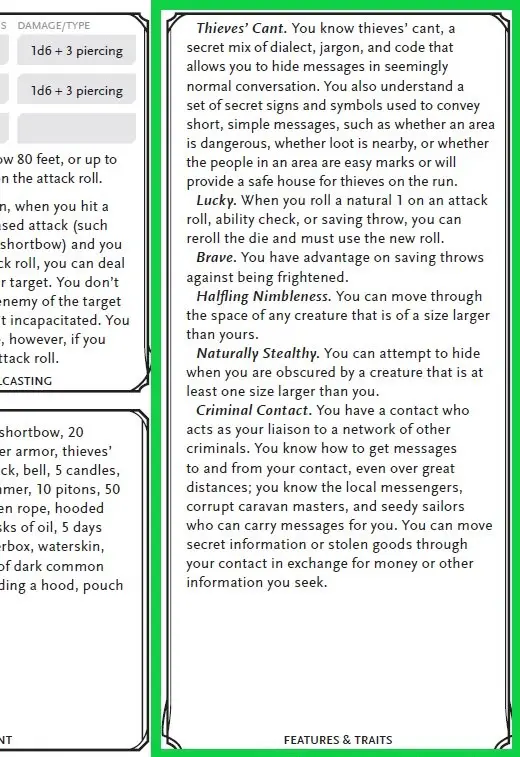
Features, gained from this character’s class and Criminal background (at the top of the character sheet), work the same way. The Criminal Contact feature and knowledge of Thieves’ Cant are also written here.
Especially as you gain levels (and tons of new features), this box can get pretty crowded. Try to prioritize the features that you use most often and jot the others down on the back of your character sheet or on a separate piece of paper.
Other Proficiencies
The bottom left of the 5e character sheet is where you can write down your character’s weapon and armor proficiencies. You’ll find these on your class’s page in the Player’s Handbook.
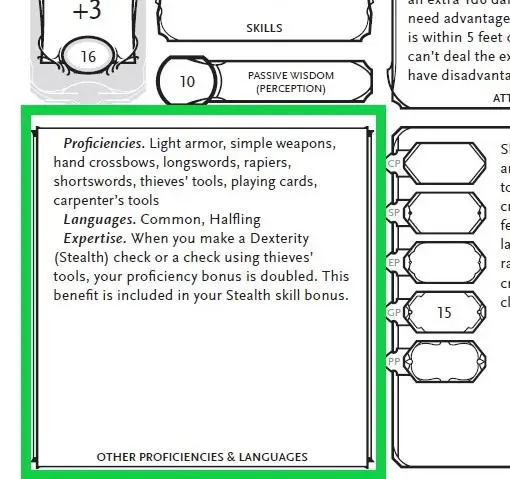
There’s rarely ever a reason to use gear that you aren’t proficient with, so you’ll want to know what things your character is most comfortable using.
You can also include languages that your character knows. In this case, our character speaks Common and Halfling.
Because the Rogue’s “Expertise” feature affects the character’s proficiency modifier, it has been included in this box as well.
Equipment
Last, but not least, we have the Equipment area of the character sheet at the bottom-middle.
The five smaller boxes in this area are for tracking your character’s wealth. Copper (CP), Silver (SP), Electrum (EP), Gold (GP), and Platinum (PP) are tracked here in order of value (least to most.)
All of the other tools, trinkets, loot, and knick-knacks you acquire can be tracked in the rest of this space.
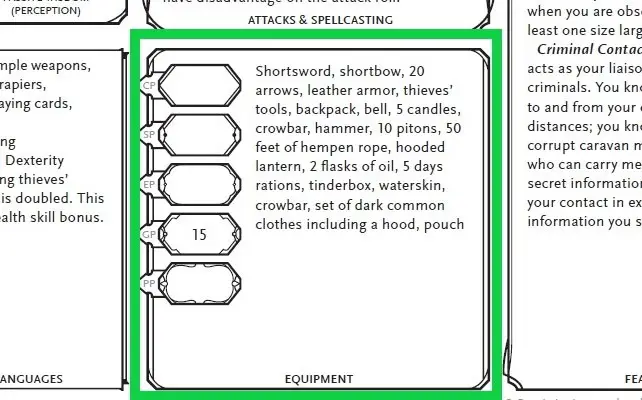
Personally, between my own terrible handwriting and pattern of making characters who collect every random thing they can find, I’ve never been able to make this work.
I recommend getting a separate journal or notebook to accompany your character sheet. Use that to track loot and your eyes will thank you!
Conclusion
I hope this blog post has helped you learn how to read your character sheet.
It’s a lot of information, but it’ll help you have more fun playing D&D and make the game run smoothly for everyone.
If you have any questions about what we talked about in this article or want some tips on how to be an awesome player, please comment below!
I’m trying to put out more content that will be helpful to new players and always appreciate suggestions!
You can also sign up for the Tabletop Joab newsletter so that you’ll be the first to know when our new posts are published!
Looking to run one of the incredible adventure modules for 5e? Check out this roundup of the best adventures for new players!
Until next time!

